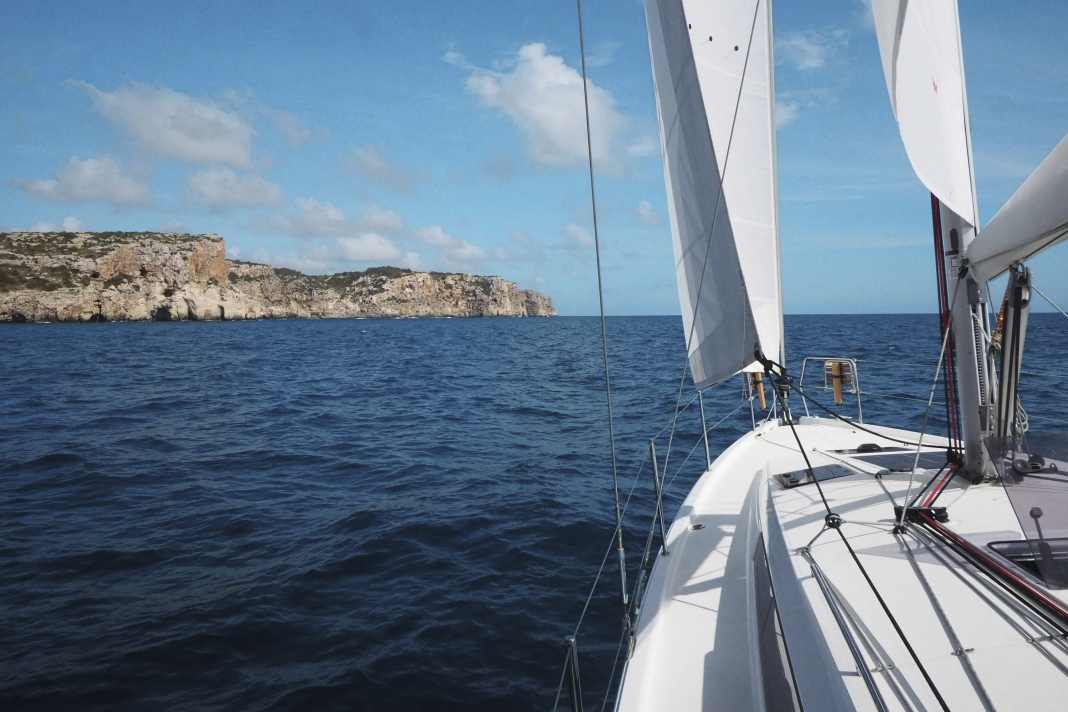





- Relaxation in Cala Morell with picturesque rocks
- Mini tsunamis in the harbour of Ciutadella
- Cala Macarella, Menorca's jewel
- The second largest natural harbour in the world awaits in Mahon
- Menorca has everything you need for a week of sailing bliss
- Menorca: Cruising tips
- Menorca: Area information
Arrival in Porto Colom, Mallorca. A Saturday in the pre-season. Three technicians are still working on board the brand new yacht, getting the boat ready at the last minute. Can this go well? Eliminate the last teething troubles? Just before the handover? And our maiden voyage straight to Menorca? Sure, certainly not a mile-eating trip, but from the point of view of a technician from Five Seasons Yachting, the neighbouring island. In other words, it's not easy to reach by car in case the new boat gets into trouble when sailing in. The familiarisation is done quickly, everything as usual, only newer. All the crockery is still unused. The only thing missing is provisions. But that's also done quickly. As a precaution, we don't change islands on the first day, especially as it would be quite a long way from Porto Colom. We choose a bay further north for the night. A mistake, as it turns out later. Because in the evening, the sea breeze falls asleep and the offshore night breeze puts the ship at right angles to the old wave, almost making you seasick in your sleep. Including a lullaby: a cacophony of jingling crockery in the lockers, which first needs to be reorganised and silenced with all the tea towels. The clatter remains.

Relaxation in Cala Morell with picturesque rocks
The next morning, the crew are all shaken up and can hardly wait to reach Menorca's leeward coast. The crossing goes smoothly and can be sailed well in half the wind. In the low season, there are only a few other boats on the water, even on a Sunday. We doze off in the cockpit and catch up on sleep. Instead of heading straight for Ciutadella in the east of Menorca, we look for a quiet bay in the north-west. Cala Morell. Guaranteed swell-free. With a bizarrely shaped rock in the entrance, reminiscent of an expressionist elephant and stylistically reminiscent of the sculpture in the Willy Brandt House. In any case, you have to look twice to realise that this is not an artefact, but was created by God himself or by erosion.
The next morning we are drawn one bay further along the north coast. Actually, two in the form of a twin bay. Cala Algayerens. In the smaller of the two bays, a kind of tiny house is wedged between the rocks, half boat shed, half hermitage. Extremely photogenic. You want to move in immediately - become a lifeguard in summer and perhaps a philosopher in winter. There are just ten people on the beach. And apart from us, there's another moored boat whose owner looks like he's passed away on it. What's more, the sight of a closed cake stand - in the Mediterranean - is at the very least unsettling.
Mini tsunamis in the harbour of Ciutadella
Although we have obviously already found Menorca's most perfect bay, we are drawn towards civilisation in the evening. To Ciutadella. The two junior sailors need some exercise. And variety. Ciutadella translates as "the little town". In its fjord-like harbour, certain weather constellations can lead to an irregularly repeating weather phenomenon: a rise and fall in the water level of between 0.3 and 1 metre within a few minutes. A kind of mini tsunami. Called "rissagas" in Spanish. It can happen, rarely, that the harbour dries out completely and the water crashes into the fjord as a tidal wave a short time later. The last time this happened was in the summer of 1984, when enormous damage was caused to the yachts and fishing boats in the harbour tube. Many boats sank.
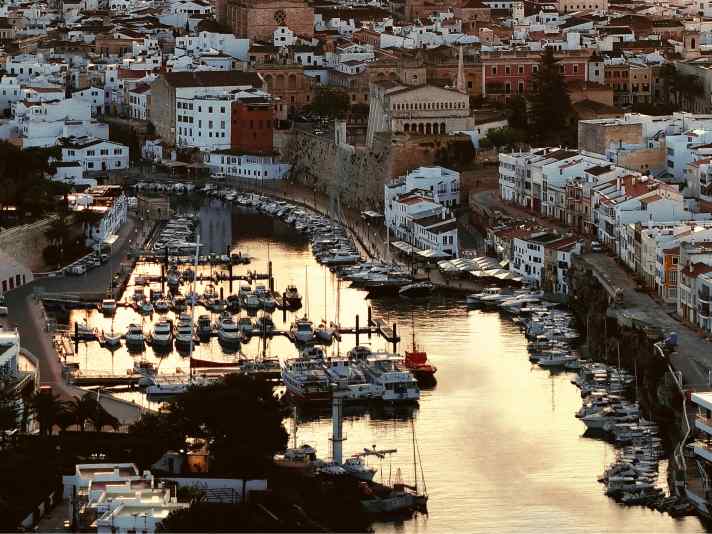
We moor up at Club Nautico. In the low season, the prices for a twelve-metre boat are still more or less reasonable. Our boat is too big for the Puerto Publico further back, opposite the cathedral. Due to the swell that comes into the long, tube-like bay in westerly winds, it jerks hard in the stern lines from time to time. Not so bad if you hardly spend any time on board anyway and would rather explore Menorca's former capital, eat tapas somewhere and drink a pomada beforehand. This traditional drink from Menorca is particularly popular in summer and consists mainly of local gin and lemonade. Liquid folklore, so to speak.
After just a few steps - with or without pomada in your blood - you will succumb to the charm of the "little town" of Ciutadella.
After just a few steps - with or without Pomada in your blood - you will succumb to the charm of the "little town". The promenade, the harbour, the cathedral, the pretty town hall, the obelisk, the alleyways, the arcades, the small market hall and, last but not least, the friendly locals. Ciutadella is a perfect Mediterranean composition. And one of those places where you want to stay forever. One of the reasons why we stay for two days. The other: the weather. With the prevailing wind and wave direction, including showers, exploring the south coast of Menorca is suboptimal. And simply sailing down the coast and only mooring at the other end, in Mahón, the capital in the east, is theoretically not a problem. In practice, it would be a sin to simply sail past the numerous bays and anchorages along the way. In the south, there is, as some say, one of the most beautiful bays in the entire Mediterranean.
Cala Macarella, Menorca's jewel
But beauty has its price. The next day, numerous excursion boats overtake us. After rounding Cap d'Artrutx and its lighthouse in the south-west of the island, a dozen bays line up one after the other. The jewel in the crown is Cala Macarella. Framed by light-coloured rocks overgrown with pine trees. Our anchor drops over the finest sand in a turquoise colour that the Seychelles or the Caribbean couldn't be more beautiful. The only thing that could be improved in mid-May is the water temperature. The dry jump from the bathing platform takes a lot of effort. And the sea is still too choppy for an overnight stay. Only 16 nautical miles further east do we find shelter from the swell in Cala Binibeca, behind a hatch. And thus a blessed sleep.
The next morning we pass Isla del Aire to starboard and Punta Prima to port. The water under the keel becomes shallow and clear at the eastern end of Menorca, even at a considerable distance from the coast. Eight metres of water depth quickly makes you nervous when you suddenly see the bottom as clear as in a mountain stream. In summer, lots of yachts anchor here and you have to sail slalom. We, on the other hand, sail leisurely with a room-sheet breeze. Menorca is so small and compact that you can get anywhere without rushing and can easily sail round the island in a week.
The second largest natural harbour in the world awaits in Mahon
Under no circumstances should you miss out Mahón. The city was made the capital by the British occupying forces in 1722. Not least because it has the second largest natural harbour in the world after Pearl Harbour. The large bay is well protected from all wind directions in the Mediterranean. The Genoese admiral Andrea Doria is said to have said: "I know of only four safe harbours in the Mediterranean: June, July, August and Mahón."
This also explains the imposing fortification right at the entrance to the bay: La Mola Fortaleza Isabell II, which the Spanish spent a quarter of a century building. The fort was never attacked. There is a perfect anchorage in the immediate neighbourhood, which can officially only be used in heavy weather. Or when all the paid moorings in the town are occupied in the high season. Apparently, a few anchor berths are tolerated in the low season. You couldn't be more sheltered. Unfortunately, it's just a little too far away from the action.
I only know four safe harbours in the Mediterranean: June, July, August and Mahón."
Both towns on Menorca have their own charm
We decide in favour of Marina Menorca, which operates a few floating islands. Electricity and water are available. The berth falls into the good and cheap category. And with a box view. The view of the city makes up for the slight swell. The guys who help with mooring assure us that there is no quicker way to get to the centre of Mahón from any mooring. The dinghy takes you to the harbour promenade in no time at all. It's Saturday and the whole of Menorca seems to be on its feet. It's mainly locals pushing their way through the old town. At the foot of the cathedral, a vintage car rally is taking place. Flamenco is being danced somewhere. Two squares further on, people are protesting against the Middle East war. While you treat yourself to a cortado and some distance from the discord in the world. In the end, you decide which of Menorca's two cities will win the race. Ciutadella versus Mahón. And you realise that both definitely have their own charm.
/box-view-of-the-old-town-of-mah-n-from-the-berth-)
We take it easy the following day. It's a Sunday that lives up to its name. We set sail in perfect weather, just one or two bays away. Sa Mesquida is considered one of the most beautiful bays in Menorca and is practically the local beach for the inhabitants of Mahón. Ideal for recreation. It is almost quicker to get there on foot or by bike than by boat. The small fishing and holiday resort is still part of the urban area. A watchtower divides the bay into two areas. In mid-May, we share the anchorage with just one other yacht. And in the evening, even without booking, we can easily get a seat in a popular fish restaurant up on the cliffs. Motto: You eat with your eyes. The view is fantastic.
Menorca has everything you need for a week of sailing bliss
The next morning, we continue to Es Grau and behind the island of Illa d'en Colom, a bird sanctuary, where we spend the morning waiting for the thermals. It is not until the afternoon that we set off towards the north coast and anchor in the bay of Fornells, which extends up to four kilometres inland. The sailing guides warn against lobster pots in the bay. The locals are among the most skilled lobster fishermen, making the place a mecca for shellfish lovers. The lobster stew Caldereta de Llagosta is particularly famous. Even the royal yacht of King Juan Carlos is said to have dropped anchor here several times. It is therefore not surprising that the place combines a certain noblesse with the charm of an old fishing village. Unfortunately, the boat's cash box doesn't have any crayfish. We take a sporting view - as animal welfare.
New day, heading for a familiar bay. We sail along the rocky, rugged shore of the north coast and complete the Menorca circuit. Fast sailors can easily cover the 70 miles in two days, fast boats in one. After a final night at anchor, we leave Mallorca's little sister in our wake with a sense of melancholy. The island has everything you need for a successful week on the water.
What follows is a furioso finale, the curse and blessing of the pre-season: barely back on Mallorca, we are anchored in a hailstorm. The noise on deck is frightening. It sounds partly like a drum roll and partly like comet strikes. The water around us is boiling. After two hours, the spook is over. And in the evening, with the sun shining beautifully, so is our trip. Unfortunately, it has to be said once again. Just a little clearer than usual.
Menorca: Cruising tips
Ciutadella
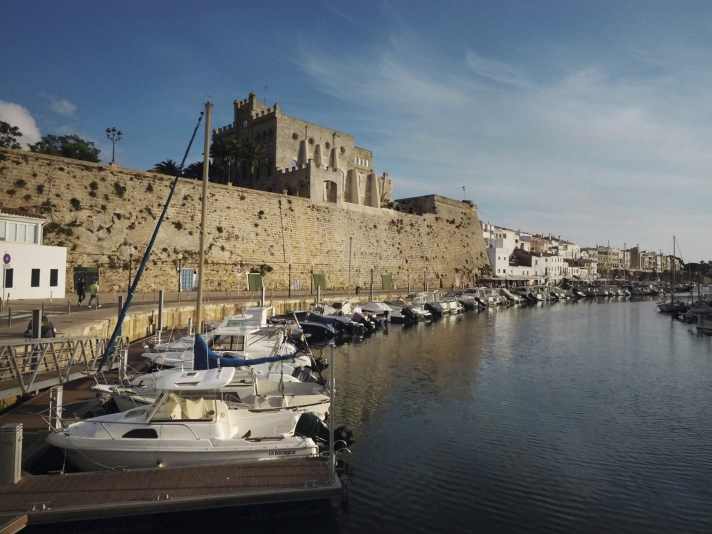
Usually the first port of call when you arrive from Mallorca. And one of the best. The sanitary facilities at Club Nautico don't match the mooring fees. But that's not the fault of the town, which is considered one of the most beautiful in Spain. Many restaurants in the arcades of the old town.
Cala Mitjana
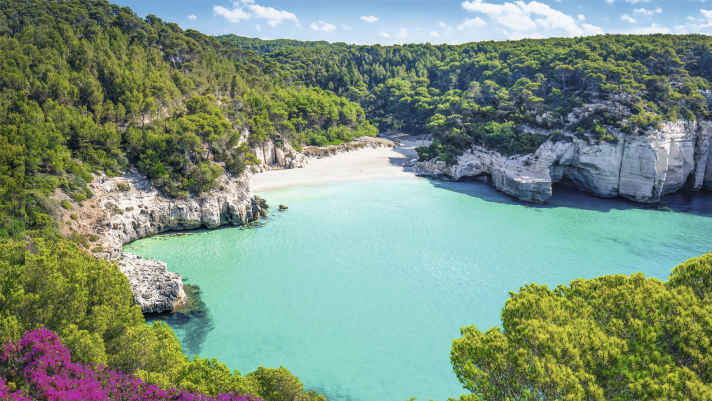
Another superlative. For many, it is the most beautiful bay in Menorca. Accordingly, there is a lot of hustle and bustle here in the high season on land and at sea. But in the early and late season, it is kept within limits. Open to the south, it is better to head east to Cala Binibeca for the night.
Mahón
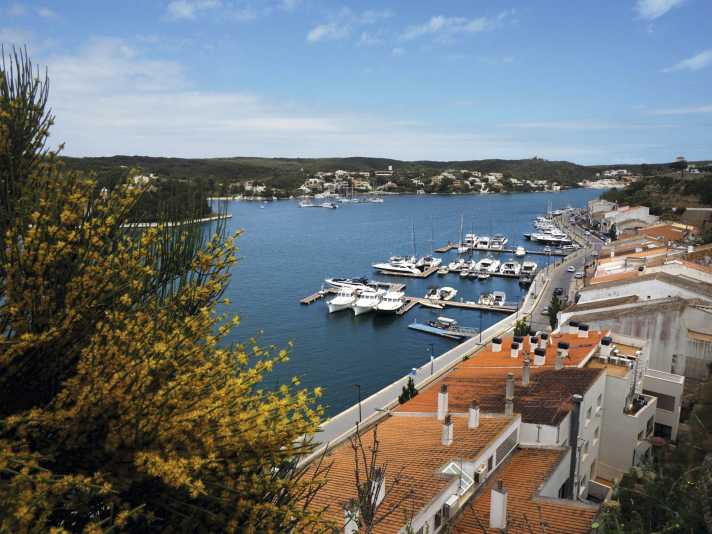
The largest natural harbour in the Mediterranean. The town is enthroned on a steep cliff in a fjord-like bay. If you can do without sanitary facilities, one of the floating pontoons is a great place to lie. Or completely off the beaten track, surrounded by the old La Mola fortress in Cala Teulera.
Sa Mesquida
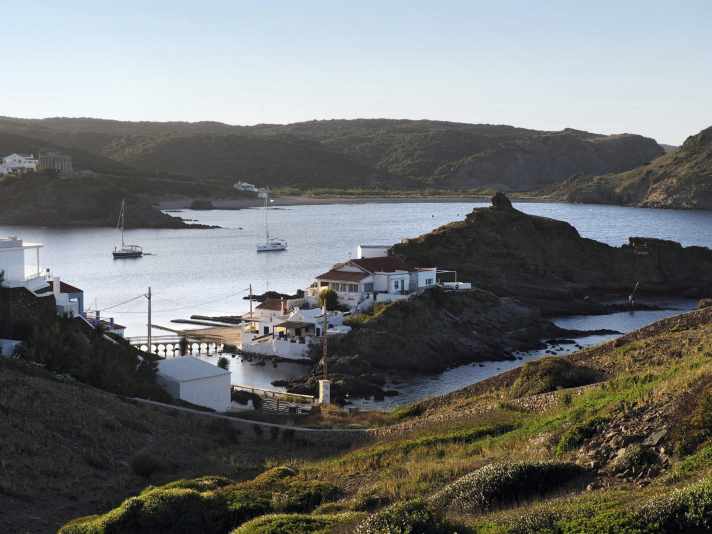
Literally round the corner. You can anchor off the beach or in front of the village, where a reef runs through the bay, inviting you to go snorkelling. In the evening, we recommend a short walk to the cliffs to stop off at the Cap Roig fish restaurant and keep an eye on your own anchor light.
Cala Algayarens
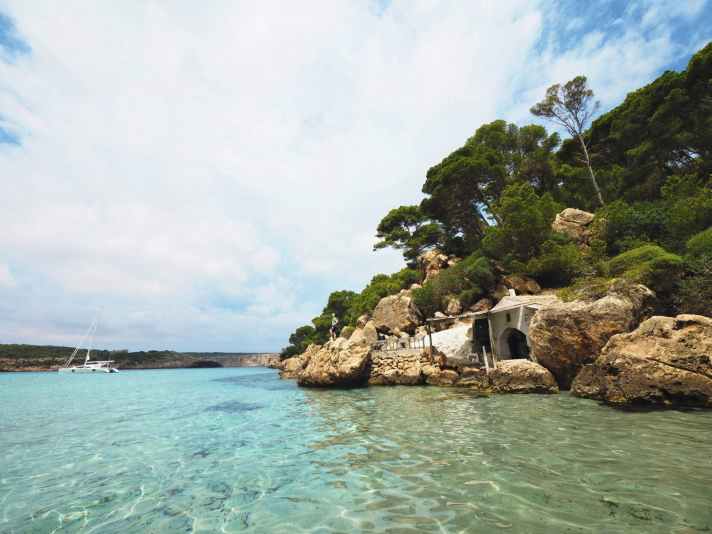
In the north of Menorca. Ideal anchorage and beautiful beach for children, with very shallow water. Rather unusable for sailors in northerly winds, then the surfers come. Otherwise, the dune landscape and the neighbouring forest of Aleppo pines and holm oaks are worth a detour.
Menorca: Area information
Charter
Jeanneau Sun Odyssey 410 from Five Seasons Yachting. Low season with 10 % early booking discount: 2,907 euros; high season: 5,103 euros/week. www.fiveseasonsyachting.com Phone: 05605 926152
Precinct
Menorca is a fifth of the size of Mallorca and ideal for a short trip. The approx. 70 nautical miles of a circumnavigation can easily be completed in a week. Between Cituadella in the west and Mahón in the east, anchor bays are lined up one after the other. The north coast is more rugged, but just as beautiful. Many bays are uninhabited.
Navigation & Seamanship
The area is relatively undemanding. The shortest passage from Mallorca's north-east coast to Cituadella is approx. 24 nautical miles long. You can navigate around Menorca by sight. It is important to keep an eye on the weather. Also to help you decide whether to circumnavigate the island clockwise or anti-clockwise.
Wind &Weather
The prevailing wind direction is from the north. As the north-easternmost Balearic island, Menorca is in the area of influence of the Mistral. The north coast of Menorca can therefore be as rough as it looks. In a typical mistral situation, which usually lasts three to four days, you should first sail along the more sheltered south coast.
Harbour & Anchorages
Only two harbours can be called at in all weathers: Mahón and Cituadella. There are numerous anchorages in between. The same applies to the north coast. If heavy seas make it risky to enter Cala Fornells or Puerto de Addaya, it is advisable to sail downwind to Mahón.

